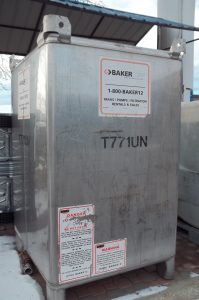In an earlier article I identified and explained the requirements of 49 CFR 178.703(a) that mandate the manufacturer of an Intermediate Bulk Container (IBC) mark it with certain letters, numerals, and symbols to indicate that it is specification packaging designed, manufactured and tested to meet a UN standard. But the markings required by paragraph (a) of §178.703 may not always be enough. In paragraph (b) of §178.703 markings are identified that are to be displayed on an IBC, “in addition to markings required in paragraph (a) of this section”.
The purpose of this article is to identify and explain the requirements of 49 CFR 178.703(b) for additional specification packaging markings to be used on intermediate bulk containers.
While it is clearly the responsibility of the IBC manufacturer to apply the specification packaging markings of paragraph (a), the paragraph begins, “The manufacturer shall…” The requirements of paragraph (b) are not so clear. For one thing, no such responsibility is specifically assigned in paragraph (b). It can be assumed that some markings will be applied by the manufacturer, such as the tare mass or rated capacity, but others will be the responsibility of whomever performs the particular regulated function, such as the date of the last inspection or the date of the last leakproofness test. Per §173.35(b)(2) it remains the responsibility of the person filling the IBC (I’ll assume this to also be the shipper) to ensure all the specification markings required by §178.703 are present and visible.
If you fill an IBC with a hazardous material prior to offering it for transportation you must inspect it prior to filling to ensure the required specification packaging markings are present.
So, with a shared responsibility for the specification marking on an IBC, let’s take a look at some differences between the requirements of paragraph (a) – for required specification packaging markings – and (b) – for additional specification markings – of this section:
- Paragraph (a) specifies that the required markings must be durable and clearly visible, whereas paragraph (b) requires the additional markings to only be readily accessible for inspection, which would appear to be a lower standard. However, the general specification marking requirements of §178.3, which apply to all packagings – and therefore to both paragraph (a) and (b) – requires the marking to be stamped, embossed, burned, printed or otherwise marked on the packaging to provide adequate accessibility, permanency, contrast, and legibility so as to be readily apparent and understood.
- While the requirements of paragraph (a) apply to all IBCs, those of paragraph (b) only apply to certain IBCs based on their materials of construction.
- There is no mandated sequence for the markings of paragraph (b) as there are for those of paragraph (a).
Now, about those additional marking requirements of §178.703(b); they must be:
- Near the markings required by §178.703(a). No exact distance is specified, so do your best.
- In a place that is readily accessible for inspection.
- If units of measure are indicated, the metric unit (kg or L) must be displayed.
Like this article? Subscribe to my Monthly Newsletter No marketing emails! |
The following additional marking requirements of §178.703(b)(1-6) depend on the type of IBC to be marked:
 If a rigid plastic or composite IBC:
If a rigid plastic or composite IBC:
- Rated capacity in L of water at 20 °C (68 °F).
- Tare (empty) mass in kilograms.
- Gauge test pressure in kPa.
- Date of last leakproofness test, if applicable. Must indicate month and year.
- Date of last inspection (month and year).
- Each of the above markings may be preceded by its narrative description. For example: “Tare Mass: 405 kg” when the tare mass of the IBC is 405 kilograms.
- See below for the information required to be marked on the inner receptacle of a composite IBC.
- Rated capacity in L of water at 20 °C (68 °F).
- Tare mass in kilograms.
- Date of last leakproofness test, if applicable. Must indicate month and year.
- Date of last inspection (month and year).
- Maximum loading/discharge pressure, in kPa, if applicable.
- Body material and its minimum thickness in mm.
- Serial number assigned by the manufacturer.
- Each of the above markings may be preceded by its narrative description. For example: “Tare Mass: 405 kg” when the tare mass of the IBC is 405 kilograms.
- All of the above must be marked on a metal corrosion-resistant plate.
If a fiberboard or wooden IBC:
- Tare mass in kg must be shown.
If a flexible IBC:
- May be marked with a pictogram displaying recommended lifting methods.
If a composite IBC the inner receptacle must be marked with at least the following:
- Code number designating the IBC design type.
- Name and address or symbol of the manufacturer.
- Date of manufacture.
- Country authorizing the marking.
- If a composite IBC is designed to be dismantled for transport when empty, each of the parts intended to be detached must be marked with the month and year of manufacture and the name or symbol of the manufacturer.
One more sub-paragraph of §178.703(b) remains, that describing the symbol applicable to an IBC designed for stacking or not designed for stacking that must be marked on all IBCs manufactured, repaired or remanufactured after January 1, 2011. A full explanation of that requirement will have to wait until another article.
Does any of this matter? It does if you are either the manufacturer of an IBC or you fill IBCs with a hazardous material prior to offering them for transportation. Also, other types of packagings have specification marking requirements of their own. Be sure to research the specification marking requirements of the specific type of packaging you offer for transportation.
Contact me with any questions you may have about the transportation of hazardous materials by air, highway, vessel, or rail International and Domestic Daniels Training Services 815.821.1550 |
For more information:

